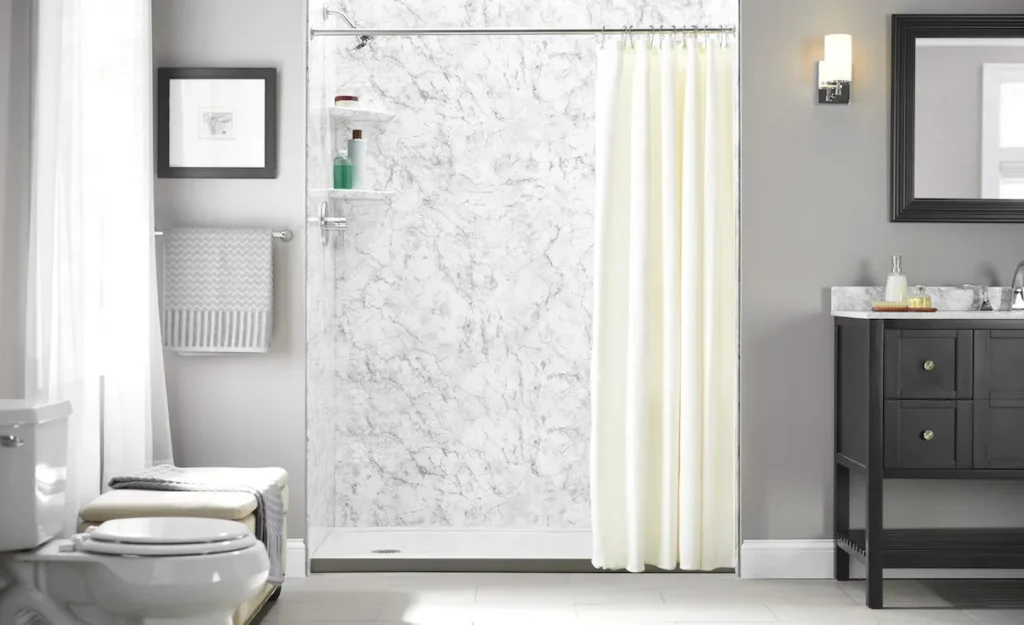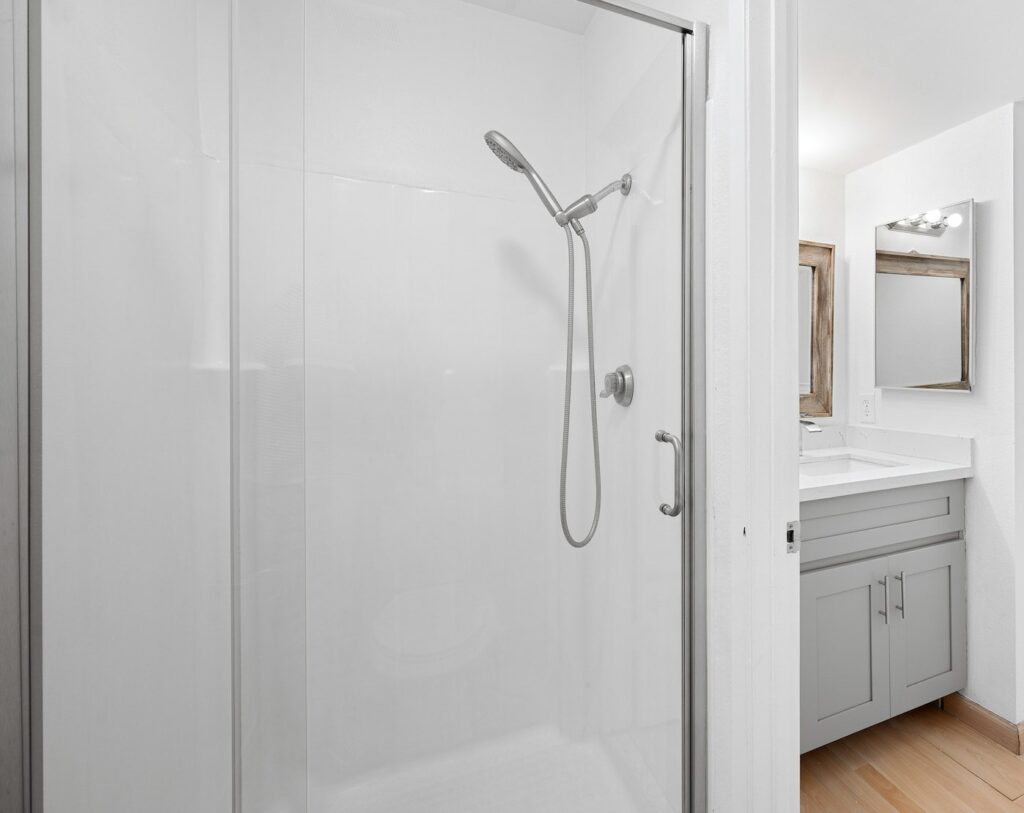Choosing the Right Shower Material: Why Acrylic Beats Fiberglass Every Time
You’re standing in your bathroom, frustrated with your shower’s stained walls and cracked corners, wondering if it’s finally time for that shower renovation you’ve been putting off. If you’re like most homeowners, you’ll head to the home improvement store and see rows of fiberglass shower kits with tempting price tags. But before you make a decision that you’ll live with for the next decade or more, let’s talk about why that “bargain” might end up costing you more in the long run.
At Atlas Home Improvement, we’ve been helping Michigan homeowners make smart bathroom choices for decades. We’ve seen what happens to different shower materials after five years, ten years, and beyond. The difference between acrylic and fiberglass showers becomes crystal clear when you understand what you’re actually buying.

Understanding the Parts of a Shower
Before diving into the comparison, it’s helpful to understand the core components of a typical shower system:
- Shower Base (Pan): The sloped floor that channels water to the drain. Quality bases prevent leaks and provide stable footing.
- Shower Surround: The wall panels that protect your bathroom walls from moisture damage while creating the shower’s visual appeal.
- Complete Shower Insert: A prefabricated unit combining base and surround, engineered for precise fit and streamlined installation.
Now let’s take a closer look at the two most popular materials used for these parts—acrylic and fiberglass.
What Is an Acrylic Shower?
Acrylic shower systems begin with solid acrylic sheets—the same durable material used in high-end spas and commercial applications. These sheets are precision-heated to 350°F and vacuum-formed into seamless shapes. The process creates a non-porous, chemical-resistant surface that’s then reinforced with multiple layers of fiberglass backing for structural integrity.
Key Manufacturing Advantages:
- Gel-coat free construction eliminates the brittle surface layer that chips and cracks
- Full-thickness color means scratches won’t reveal different colored layers underneath
- Uniform wall thickness (typically 4-6mm) provides consistent strength throughout
What Is a Fiberglass Shower?
Traditional fiberglass showers use a spray-up manufacturing process where polyester resin is applied in thin, uneven layers over a mold. This creates an inherently porous substrate that’s then sealed with a gel-coat finish—the shower’s weakest component.
Common Fiberglass Problems:
- Gel-coat failure typically occurs within 3-5 years, causing visible crazing and discoloration
- Porous substrate absorbs moisture, leading to mold growth and structural weakness
- Thin construction (often 2-3mm) makes units prone to flexing and cracking
Comparing Acrylic vs. Fiberglass Showers
Let’s break down the key factors to consider when choosing between acrylic and fiberglass:
Customization
The customization options tell another story about long-term satisfaction. Acrylic showers come in over 50 standard sizes plus custom options, with a dozen color choices that go far beyond basic white. You can integrate corner shelves, built-in seating, grab bars, and other accessories right into the unit during manufacturing. This isn’t just about looks—it’s about creating a shower that works for your family’s specific needs, including aging in place considerations.
Fiberglass manufacturers offer maybe six to eight standard sizes in white or almond. If your bathroom doesn’t fit their mold perfectly, you’re out of luck. Need grab bars for safety? You’ll be drilling holes and hoping you don’t crack the brittle gel-coat surface.
Cleaning
Here’s where the rubber meets the road – cleaning. When you step into an acrylic shower, you’re stepping into something that will clean easily with just soap and water for decades. The non-porous surface means soap scum can’t penetrate and set up permanent residence. Your weekly bathroom cleaning routine becomes genuinely easier, not just a marketing claim.
With a fiberglass shower, you’re signing up for a battle against stains that starts almost immediately. That porous gel-coat surface traps soap residue, hard water minerals, and everything else that goes down your drain. Within two to three years, you’ll notice permanent discoloration that no amount of scrubbing can remove. Many of our customers tell us they spent more time cleaning their old fiberglass shower than they do cleaning their entire kitchen.
Durability and Longevity
Durability isn’t just about lasting longer—it’s about maintaining your quality of life. Acrylic’s impact resistance is five times greater than fiberglass gel-coat. Drop a shampoo bottle? No problem. Your kids slam the shower door? The acrylic flexes and returns to shape. Temperature changes from hot showers won’t cause thermal shock cracking.
Fiberglass gel-coat is inherently brittle. Those small chips and cracks you see aren’t just cosmetic problems—they’re entry points for water damage and bacteria growth. The flexing that occurs as people use the shower creates stress fractures, typically around the drain area where structural support is most critical.
Cost
Let’s talk dollars and cents over the life of your shower. Yes, you’ll pay more upfront for acrylic—typically $2,500 to $4,500 installed versus $1,200 to $2,500 for fiberglass. But here’s what happens next.
Your acrylic shower will look essentially the same in year ten as it did on installation day. Your annual maintenance costs will be minimal—maybe $25 to $50 for basic cleaning supplies. Over a 20-year period, you’ll spend perhaps $200 total on repairs, if any.
That fiberglass shower tells a different financial story. You’ll spend $75 to $150 annually on specialized cleaners and extra time cleaning. Every five to seven years, you’ll face repair costs of $300 to $800 for refinishing or crack repairs. Most homeowners end up replacing their fiberglass shower entirely after 10 to 12 years, adding another $2,000 to $3,500 to the total cost.
When you run the 20-year numbers, that “expensive” acrylic shower costs $3,000 to $5,500 total, while the “bargain” fiberglass option runs $5,500 to $8,500. The premium material actually saves you money.
Safety
Safety features in showers aren’t just for older adults—they protect everyone in your household. Acrylic manufacturers can integrate slip-resistant textures with actual ANSI safety ratings right into the shower floor. Grab bars can be built into the walls with proper structural support rated for over 300 pounds. The material itself stays at a comfortable temperature, never becoming dangerously hot like some surfaces can.
Fiberglass showers rely on their smooth gel-coat finish, which becomes genuinely slippery when wet. Any shower safety features have to be added after installation, often requiring you to drill through the shower walls and hope you don’t damage the waterproofing.

Dangers During the Removal Process
When it’s time to remove an old shower, it’s important to understand the risks involved—especially with fiberglass. Demolishing a fiberglass shower can release glass fibers into the air, which can cause respiratory and skin irritation. These tiny glass fibers can cause severe itching, skin irritation, eye irritation, and respiratory tract irritation when inhaled.
Professional removal requires protective equipment including goggles, dust masks, and gloves due to sharp edges and airborne particles. Acrylic showers, on the other hand, are safer to remove and replace, making them a better long-term investment for your health and your home.
The health risks are real but different from what was originally stated—it’s glass fiber irritation rather than the serious lung diseases associated with crystalline silica dust exposure.
Are Acrylic Showers the Better Choice?
The choice between acrylic and fiberglass comes down to your priorities and timeline, but acrylic showers outperform fiberglass in nearly every category. If you’re planning to stay in your home for more than five years, value easy maintenance, want customization options, or prioritize safety features, acrylic delivers superior value despite the higher upfront cost.
Fiberglass might make sense if you need the absolute lowest initial investment, you’re preparing a rental property, or you’re planning another renovation within five years anyway.
If you’re investing in a bathroom remodel, you deserve a shower that looks beautiful, performs well, and stands the test of time. That’s exactly what you get with a high-quality acrylic shower system.
Live in Michigan and want more? To get started with Atlas Home Improvement, call (734) 259-4374 or fill out our contact form .















